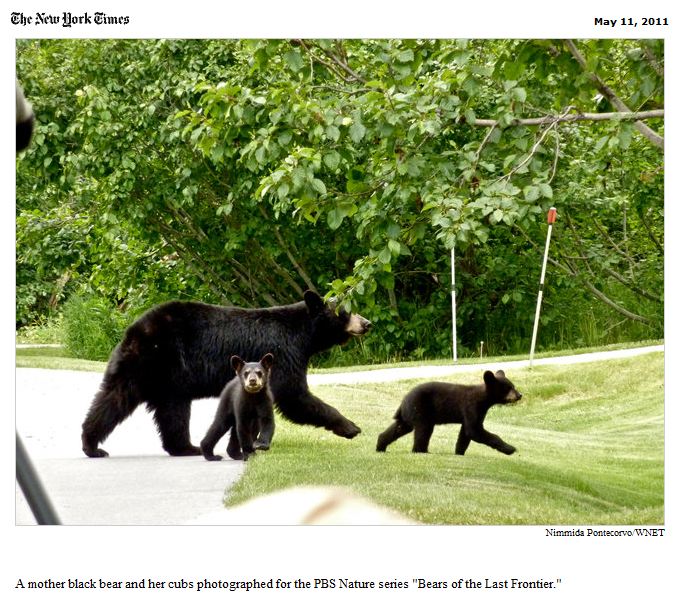Study of Black Bears Finds It’s Not the Mamas That Should Be Feared the Most
By PAM BELLUCK
Published: May 11, 2011
If you believe Stephen Colbert — and really, who doesn’t? — bears are deadly.
“Bears are soulless, godless, rampaging killing machines,” the comedian has written. “They are Satan’s minions and the TRUE symbol of evil.”

He might be surprised, then, by a new study that found that black bears — the most common bears in North America — have killed only 63 people in the United States and Canada over the last 109 years.
The study also found, contrary to popular perception, that the black bears most likely to kill are not mothers protecting cubs. Most attacks, 88 percent, involved a bear on the prowl, likely hunting for food. And most of those predators, 92 percent, were male.
“Mother bears, whenever they feel threatened or a person is too close, they act very aggressively,” said Stephen Herrero, the study’s lead author. “They make noise, they swat the ground with their paws and they run at people. They want to make you think that they’ll eat you alive, but they almost always stop.”
By contrast, “the kind of bear you need to be afraid of is not feeling threatened by you — it’s testing you out as a possible prey item,” said Dr. Herrero, a professor emeritus at the University of Calgary. “It’s quiet. It stalks you just like a lion might stalk you.”
Given that there are about 900,000 black bears in North America, the number of attacks is small, but it has increased as both the human and bear populations have grown. Eighty-six percent of attacks occurred between 1960 and 2009, 17 of those since 2000.
“It’s not an increase in hungry bears,” said Dr. Herrero. “It’s simply more and more people out there interacting with bears.”
Still, most deaths occurred in places with fewer people: 44 in Canada and 5 in Alaska, the state with the most attacks. That may be because bears in more sparsely populated areas are less accustomed to people or because television shows and wildlife tours have “generated in people a desire to get close to dangerous things,” said Barry Lopez, an author of books on wildlife. “There could be no change in the resident population, but the visiting population has grown dramatically,” Mr. Lopez said.
Most attacks killed one person, but in three cases two or three people were killed by the same bear within several hours. And once, in Saskatchewan, a bear that killed one person tried to kill another several days later.
“That person was able to kill the bear, and when they skinned out the bear they found the remains of the other person,” said Dr. Herrero, suggesting that bears that have been aggressive once will be more likely to try again.
For example, a black bear that grabbed 11-year-old Samuel Ives from his family’s tent in Utah’s American Fork Canyon in 2007, killing him, had apparently slashed another tent earlier that day. Last week, a judge awarded the family $1.95 million, saying the federal Forest Service should have warned them about a dangerous bear.
Dr. Herrero and other experts said that black bears are less confrontational than grizzlies and polar bears because they evolved differently.
“Black bears evolved in thickly forested areas and can escape to the top of a tree, so they never really had to defend themselves,” said Chris Morgan, a bear ecologist who wrote the just-published “Bears of the Last Frontier” and is featured in a three-part PBS series. “Polar bears are very much of a predator bear, having evolved rapidly to become a specialist in hunting seals. It’s a good thing most of us don’t live in polar bear country.”
While there are about 15 times as many black bears as grizzlies, grizzlies kill about twice as many people, likely because they evolved in open plains and rarely climb trees, Dr. Herrero said. Roughly half of grizzly attacks involve mothers protecting cubs.
The black bear findings, published Wednesday in the Journal of Wildlife Management, suggest that people should behave differently around different bears. With a mother defending cubs, “you just back away calmly and give it some space,” Dr. Herrero said. “With a predatory bear, you stand your ground, stomp at it, throw rocks at it, whatever you need to do to convince it you’re not easy prey.”
Never run from bears, and always discourage them with bear spray, portable electric fencing and bear-resistant food containers, Mr. Morgan said. He stressed, though, that “any two bears you meet are as different as any two people you meet. Not every person you come across is a calm poet, not every person is a nasty mugger. Bears, because of their intelligence, develop individual personalities.”
